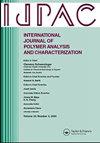Accurate modeling of nano-enhanced polyethylene glycol thermal conductivity using soft computing methods: application to thermal energy storage
IF 1.7
4区 工程技术
Q4 POLYMER SCIENCE
International Journal of Polymer Analysis and Characterization
Pub Date : 2025-03-27
DOI:10.1080/1023666X.2025.2477557
引用次数: 0
Abstract
Polyethylene glycol (PEG) is considered a renowned polymer with a semi-crystalline composition that, as a phase change material, is ideal for use in applications of heat energy storage. Recent research suggests that PEG’s thermal conductivity can be significantly improved by incorporating nanoparticles. This study focuses on developing various robust machine learning methods like decision trees, adaptive boosting, ensemble learning, K-nearest neighbors, multilayer perceptron artificial neural networks, convolutional neural networks, and extra trees to accurately assess nano-enhanced PEG thermal conductivity based on PEG molecular weight, temperature, type of nanomaterial, and its concentration. The leverage technique is employed to identify potential outlier data within the collected dataset. Additionally, a sensitivity assessment will be performed to examine the relative impacts of each input parameter on the thermal conductivity. The K-fold cross-validation technique is used in every algorithm to mitigate the overfitting problem during model training. The results indicate that the extra trees (with R2 = 0.9368997, MSE = 0.0003628, AARE% = 3.7075695) and decision tree (with R2 = 0.9374603, MSE = 0.0003596, AARE% = 3.5759954) models are the most accurate in predicting the thermal conductivity of nano-enhanced PEG. These models achieve the highest coefficient of determination (R2) and the lowest error metrics (MSE and AARE%), highlighting their exceptional capacity to recognize intricate patterns and provide accurate forecasts, particularly for forecasting thermal conductivity. Also, it is implied that temperature, molecular weight of PEG, and nanoparticle concentration all tend to increase the thermal conductivity, with nanoparticle concentration being the most effective factor.
用软计算方法精确模拟纳米增强聚乙二醇的导热性:在热能储存中的应用
聚乙二醇(PEG)被认为是一种著名的聚合物,具有半结晶成分,作为相变材料,非常适合用于热能储存的应用。最近的研究表明,通过加入纳米颗粒,聚乙二醇的导热性可以显著提高。本研究的重点是开发各种鲁棒机器学习方法,如决策树、自适应增强、集成学习、k近邻、多层感知器人工神经网络、卷积神经网络和额外树,以准确评估基于PEG分子量、温度、纳米材料类型及其浓度的纳米增强PEG的导热性。利用杠杆技术在收集的数据集中识别潜在的异常数据。此外,将进行灵敏度评估,以检查每个输入参数对导热系数的相对影响。每个算法都使用K-fold交叉验证技术来缓解模型训练过程中的过拟合问题。结果表明,额外树模型(R2 = 0.9368997, MSE = 0.0003628, AARE% = 3.7075695)和决策树模型(R2 = 0.9374603, MSE = 0.0003596, AARE% = 3.5759954)对纳米增强PEG的热导率预测最准确。这些模型实现了最高的决定系数(R2)和最低的误差指标(MSE和AARE%),突出了它们识别复杂模式和提供准确预测的卓越能力,特别是在预测导热系数方面。温度、PEG分子量和纳米颗粒浓度都有增加导热系数的趋势,其中纳米颗粒浓度是最有效的因素。
本文章由计算机程序翻译,如有差异,请以英文原文为准。
求助全文
约1分钟内获得全文
求助全文
来源期刊
CiteScore
3.50
自引率
5.30%
发文量
37
审稿时长
1.6 months
期刊介绍:
The scope of the journal is to publish original contributions and reviews on studies, methodologies, instrumentation, and applications involving the analysis and characterization of polymers and polymeric-based materials, including synthetic polymers, blends, composites, fibers, coatings, supramolecular structures, polysaccharides, and biopolymers. The Journal will accept papers and review articles on the following topics and research areas involving fundamental and applied studies of polymer analysis and characterization:
Characterization and analysis of new and existing polymers and polymeric-based materials.
Design and evaluation of analytical instrumentation and physical testing equipment.
Determination of molecular weight, size, conformation, branching, cross-linking, chemical structure, and sequence distribution.
Using separation, spectroscopic, and scattering techniques.
Surface characterization of polymeric materials.
Measurement of solution and bulk properties and behavior of polymers.
Studies involving structure-property-processing relationships, and polymer aging.
Analysis of oligomeric materials.
Analysis of polymer additives and decomposition products.

 求助内容:
求助内容: 应助结果提醒方式:
应助结果提醒方式:


